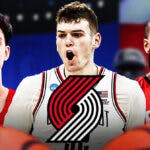Analysis of the Portland Trail Blazers' porous defense against the Golden State Warriors can wait, and there's only so much to be gleaned from it in the first place. This is preseason basketball, remember, when offenses league-wide are expected to be ahead of defenses, let alone for a team with a rookie head coach who's implementing a completely new defensive scheme.
There are definitely concerns about Portland's defense in the exhibition opener that need addressing, but they're not some indication of a doomed marriage between scheme and personnel. And even if they prove to be once the regular season tips off, the Blazers' offensive performance on Monday night—despite some carelessness with the ball—indicated this team is still fully capable of winning by simply outscoring its opponent.
The means of that trump card will look different than in years past, with Portland emphasizing ball movement, rim attacks and early-clock offense largely at the expense of Damian Lillard and C.J. McCollum playing it by themselves. Don't be fooled, though. Just because Billups is lessening the heavy individual loads long carried by the Blazers star guards hardly means he's not going out of his way to get them easy looks.
Expect these three actions for Lillard and McCollum to be staples of Portland's offense in 2021-22.
Early Away Cross Screens
Drag screens are a part of literally every team's offensive attack, a surefire way to bend the defense with the ball in a playmaker's hands as the floor changes sides. The Blazers spammed early drag screens under Terry Stotts and will no doubt continue running them frequently with Billups on the sidelines. They perfectly play into the rare shot-making ability that makes Lillard and McCollum so special, while encouraging the type of “random” offense early in the shot clock that Portland now wants to play.
But every fallback needs a counter, and Billups is already taking advantage of defenses expecting the Blazers to begin many offensive trips with drag screens. Take a look at Cody Zeller on the possession below. He runs pointedly toward the top of the key, ostensibly to set an early pick for Anfernee Simons on the ball. He quickly cuts on his right foot when he'd normally turn to the ball, though, rising back up the floor and flipping his hips to set a cross screen for McCollum, who tries to catch Jordan Poole napping by barely crossing halfcourt before sprinting into Zeller's pick.
McCollum misfires on a deep catch-and-shoot triple, but that's a shot Billups wants Portland taking. Lillard was the recipient of this action against the Warriors, too, as was Norman Powell. There will be times Lillard drops the ball off to the roller as the defense tries to frantically to prevent a three-point attempt on the catch, and others Powell gets all the way to the paint with a strong right-handed drive. McCollum could step in for a pull-up two against teams playing drop coverage, as well.
Portland will run this pet play ad nauseam this season, and rightfully so. It's a great way to catch the defense off guard while utilizing the varied offensive gifts of Lillard and McCollum.
Iverson Cuts
Billups isn't revolutionizing basketball with his tweaks to an offense that ranked second in the league last season. He's even running some of the same sets Stotts did over the last nine years in Rip City, no surprise considering the homogeneity of modern NBA offenses.
After the game, Billups was asked about this second-quarter possession being schemed or coming in random flow of the offense. While he copped to it being a “play call,” Iverson cuts have been ubiquitous for shot-making guards across the league ever since the man himself rose to prominence with the Philadelphia 76ers in the early 2000s. It's tough to imagine any player in basketball posing more of a threat than Lillard while sprinting off a pair of screens toward the opposite wing.
Engaging two defenders is the primary goal of every screen, and look how many Warriors descend on Lillard once Andrew Wiggins loses his balance. Even if Wiggins had kept his feet, though, Juan Toscano-Anderson still would've been tasked with meeting Lillard on the catch, giving Portland a winning numbers game behind the play if the quick catch-and-shoot wasn't there. You can even see Zeller continuing toward Lillard to set another pick, aided by Larry Nance Jr. screening the eventual screener before clearing to the opposite wing.
Perimeter cross screens and Iverson cuts will produce many points for Lillard and McCollum in 2021-22. But they function just as importantly as general initiations of Portland's offense early in the shot clock, goading movement and attention from defenses that will create clean shots for the Blazers' supporting cast.
Blind Pig Action
The best way to keep basketball's most flammable three-point shooters from getting hot? Preventing the likes of Lillard and company from getting triples off to begin with by relentlessly pressuring them up the floor, both on and away from the ball.
Billups has talked a lot about further leveraging the imminent shooting threats of Lillard and McCollum with screens and cuts off the ball, much like the Warriors do with Curry and a healthy Klay Thompson. Portland will never master that relentless off-ball activity like Golden State. It's just not in the basketball DNA of Lillard and McCollum, and the Blazers lack the ancillary passers to take full advantage even if that wasn't the case.
Still, Portland can at least tap into that identity when defensive pressure allows it, especially considering Billups' plans to make Jusuf Nurkic a more consistent table-setter at the elbows and top of the key. Watch Lillard on the play below cut toward halfcourt as McCollum takes a dribble hand-off from Robert Covington, seemingly to catch and take a step-up screen from Nurkic. But it's all a ruse, the real action—a longtime league favorite called “blind pig”—a swing from the opposite wing to Nurkic before Lillard changes course for a reverse dribble hand-off going downhill.
This set accomplishes pretty much everything Billups wants from his offense: quick side-to-side ball movement, ancillary facilitation and an off-ball cut that threatens the defense vertically.
McCollum will often be the beneficiary of blind pig, too, as will Powell. But this action seems specifically geared toward Lillard, a player with limitless shooting range from multiple launch points and the burst needed to get his shoulder past help in a dribble hand-off. He'll feast on it all season, even if it comes as the result of on-the-fly adjustment rather than a called play from Billups.




